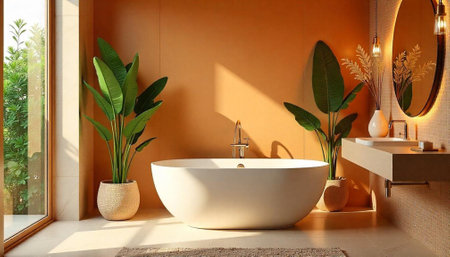Introduction to Vastu and Bathroom Plants
Vastu Shastra, the ancient Indian science of architecture and spatial arrangement, deeply influences the way homes are designed and maintained across India. Rooted in centuries-old wisdom, Vastu aims to harmonise natural energies within living spaces, ensuring health, prosperity, and well-being for residents. In today’s fast-paced Indian lifestyle, every corner of the home, including often-overlooked spaces like bathrooms, is gaining renewed attention under Vastu principles. Traditionally, bathrooms are considered zones where negative energy can accumulate due to their association with water disposal and waste. However, integrating specific plants into these areas is a unique Vastu remedy that not only neutralises negativity but also enhances positivity. Plants are revered in Indian culture as symbols of life, growth, and purification. By choosing Vastu-compliant bathroom plants, Indian households can elevate both the aesthetics and energetic balance of their homes. This article explores how the thoughtful placement of plants transforms bathrooms from mere functional spaces into zones of tranquillity and positive energy, reflecting the holistic approach central to Vastu Shastra.
Top Vastu-Approved Bathroom Plants
Choosing the right plants for your bathroom is important not only for enhancing aesthetics but also for ensuring positive energy, as per Vastu Shastra. Indian homes often face challenges like humidity, limited sunlight, and space constraints in bathrooms. Fortunately, several indoor plants align well with Vastu principles while thriving in such environments. Here are some of the best options:
Aloe Vera
Aloe Vera is celebrated for its air-purifying properties and its ability to thrive in humid conditions. According to Vastu, Aloe Vera attracts positive energy and helps maintain a calm and soothing environment. Place it on a window sill where it receives indirect sunlight.
Money Plant (Epipremnum aureum)
Known as “Devil’s Ivy” or “Pothos,” the Money Plant is highly recommended by Vastu experts for bathrooms. It symbolizes prosperity, reduces stress, and absorbs toxins from the air. Hanging or trailing Money Plants near a bathroom window or shelf can maximize their benefits.
Bamboo Plant
Bamboo plants are considered very lucky and auspicious in Indian culture. They represent growth, flexibility, and good fortune according to Vastu Shastra. Bamboo can easily survive in low-light and humid conditions typical of Indian bathrooms.
Peace Lily (Spathiphyllum)
The Peace Lily is known for its ability to cleanse the air of toxins and bring tranquillity into your space. As per Vastu, placing a Peace Lily in your bathroom helps remove negative energy and maintains harmony within the household.
Snake Plant (Sansevieria)
This hardy plant is ideal for Indian bathrooms due to its resilience against humidity and poor light. Snake Plant is believed to attract positive vibes and filter harmful pollutants, creating a healthier environment as per Vastu recommendations.
Comparison Table: Best Vastu Bathroom Plants
| Plant Name | Vastu Benefit | Best Placement in Bathroom |
|---|---|---|
| Aloe Vera | Promotes positivity & calmness | Window sill with indirect sunlight |
| Money Plant | Attracts prosperity & purifies air | Hanging baskets or shelves |
| Bamboo Plant | Symbolizes good luck & growth | Corner with moderate light |
| Peace Lily | Cleanses negative energy | Near wash basin or on countertop |
| Snake Plant | Enhances health & energy flow | Anywhere with low light |
Note:
When choosing bathroom plants for your Indian home, always consider factors such as natural light availability, humidity levels, and maintenance requirements to ensure both compliance with Vastu principles and healthy plant growth.

3. Vastu Guidelines for Placing Plants in Bathrooms
According to Vastu Shastra, the correct placement of bathroom plants can help balance energy flow and enhance positivity in your home. Choosing the right direction and following certain do’s and don’ts is crucial for harnessing maximum benefit from indoor plants in bathrooms.
Recommended Directions
The East and North-East corners are most auspicious for placing plants in Indian bathrooms as per Vastu. These directions attract natural light and positive energy, supporting the healthy growth of plants like aloe vera or bamboo. If these corners are not available, North is the next best option. Avoid placing plants in the South-West corner, as it may block positive energy flow and cause stagnation.
Do’s for Bathroom Plant Placement
- Choose moisture-loving plants that thrive in humid environments such as ferns, peace lilies, or snake plants.
- Ensure that your bathroom receives some amount of indirect sunlight or use artificial grow lights if necessary.
- Place plants on shelves, window sills, or hanging planters to keep them elevated and away from direct water splashes.
- Keep pots clean and check for overwatering to prevent mould or foul odour in the bathroom.
Don’ts to Avoid Negative Energy
- Avoid placing thorny or spiky plants such as cacti, as they are considered inauspicious according to Vastu principles.
- Do not keep dried or dying plants in the bathroom; they can attract negative vibes and reduce overall harmony.
- Never overcrowd your bathroom with too many plants; a clutter-free space ensures smooth energy circulation.
- Avoid placing large pots directly on the floor near drains, as this can obstruct both physical movement and the flow of positive energy.
Vastu Tips for Maximum Benefit
To maximise the Vastu benefits of bathroom plants, regularly rotate their position to ensure even sunlight exposure and prune dead leaves promptly. Use ceramic or earthen pots instead of metal containers for a more grounded energy field. Lastly, infuse your plant care routine with intention by watering them early in the morning—this aligns with traditional Indian practices and helps synchronise your space with nature’s rhythm. By following these simple Vastu guidelines, you can transform your bathroom into a refreshing sanctuary that supports both wellness and harmony within your Indian home.
Benefits of Keeping Plants in Indian Bathrooms
Introducing suitable plants to your bathroom is a growing trend in Indian homes, not just for aesthetics but for holistic well-being as guided by Vastu Shastra. The right selection of plants can bring both spiritual and practical benefits, transforming the bathroom into a more harmonious and pleasant space.
Vastu-Related Benefits
- Balances Energy: According to Vastu, placing auspicious plants in the bathroom helps neutralize negative energies that may accumulate due to stagnant water and closed spaces.
- Promotes Positivity: Greenery symbolizes growth and renewal. Plants like Tulsi or Aloe Vera, when placed as per Vastu directions, are believed to attract positive vibrations and good fortune.
- Natural Purification: Many Vastu-approved plants purify the environment energetically, counteracting the heavy, dull energy often associated with bathrooms.
Health Benefits for Indian Homes
- Purifies Air: Several bathroom-friendly plants, such as Snake Plant and Peace Lily, are known for their air-purifying properties, removing toxins like formaldehyde and benzene commonly found in indoor environments.
- Absorbs Excess Moisture: Humidity is common in Indian bathrooms. Certain plants absorb excess moisture from the air, reducing dampness and preventing mold growth.
- Improves Mood: The presence of greenery uplifts mood and reduces stress. A touch of nature in the bathroom can turn daily routines into moments of relaxation and rejuvenation.
Key Benefits Comparison Table
| Benefit | Description | Best Plant Examples |
|---|---|---|
| Vastu Energy Balance | Counters negative energies; attracts positivity | Tulsi, Bamboo, Money Plant |
| Air Purification | Removes indoor toxins; freshens air | Snake Plant, Peace Lily, Spider Plant |
| Moisture Absorption | Lowers humidity; prevents fungal growth | Boston Fern, Aloe Vera |
| Mood Enhancement | Adds natural beauty; promotes calmness | Bamboo, Areca Palm |
Cultural Note for Indian Households:
Selecting plants based on both Vastu guidance and practical health benefits ensures that your bathroom not only looks beautiful but also supports your family’s physical and emotional well-being—making it a simple yet powerful upgrade for modern Indian homes.
5. Care Tips for Maintaining Bathroom Plants
Understanding Indian Water Quality
Water quality in many Indian cities can vary from soft to hard, often with high mineral content. For most bathroom plants like Aloe Vera, Money Plant, or Peace Lily, use filtered or boiled and cooled water to avoid salt build-up on the soil. If using tap water, let it sit overnight before watering to allow chlorine and some impurities to dissipate.
Managing Humidity in Indian Bathrooms
Indian bathrooms usually have higher humidity levels, especially during monsoons. Most Vastu-recommended plants such as Bamboo and Spider Plant thrive in this environment. However, ensure proper ventilation by occasionally opening windows or using exhaust fans to prevent fungal growth and root rot.
Lighting Conditions in Indian Homes
Bathrooms in Indian homes often have limited natural light. Place plants like Snake Plant or ZZ Plant near a window or under a skylight if available. For bathrooms with very little sunlight, consider rotating your plants every few days between brighter rooms and the bathroom or install energy-efficient LED grow lights that mimic natural sunlight.
Practical Maintenance Tips
- Wipe leaves weekly with a damp cloth to remove dust and enhance photosynthesis.
- Avoid overwatering; check soil moisture before each watering session, as excessive humidity can slow down evaporation.
- Use light, well-draining soil mixes suitable for tropical indoor plants commonly found in India.
Fertilising and Pest Control
Feed your bathroom plants with a mild, organic liquid fertiliser once every 6-8 weeks. Watch out for common pests like mealybugs or spider mites; neem oil spray is an effective and eco-friendly solution familiar to Indian households.
By adapting these care practices to local Indian conditions, you can enjoy healthy, vibrant bathroom plants that align with both Vastu principles and practical home environments.
6. Common Mistakes to Avoid as per Vastu
While many Indian families are eager to introduce greenery into their bathrooms for enhanced Vastu energy, several common mistakes can diminish the intended benefits or even create negative effects. Understanding and correcting these errors is crucial for harnessing the full power of bathroom plants as per Vastu Shastra.
Placing Plants in the Wrong Direction
One of the most frequent mistakes is placing plants in directions that contradict Vastu principles. For example, keeping plants in the South-West corner can disrupt stability and peace. Instead, North, East, or North-East corners are considered auspicious for bathroom plants, promoting positive energy flow.
Choosing Inappropriate Plant Varieties
Many households opt for decorative plants without considering their suitability for humid spaces or their Vastu impact. Avoid thorny plants like cactus or succulents with spines, as they can attract negative energy. Instead, select moisture-loving varieties such as Aloe Vera, Bamboo, or Money Plant, which are both Vastu-compliant and thrive in Indian bathroom conditions.
Neglecting Plant Health and Cleanliness
Dead, wilted, or dusty plants are a common sight in some bathrooms and can invite stagnant chi (energy), according to Vastu. Always ensure your bathroom plants are healthy, vibrant, and regularly cleaned. Replace unhealthy plants promptly to maintain positive vibrations.
Overcrowding Small Spaces
Another typical error is overcrowding compact bathrooms with too many pots. This not only reduces air circulation but also creates visual clutter—contradicting the principles of order and calm promoted by Vastu Shastra. Limit yourself to one or two well-chosen plants, allowing them room to grow and breathe.
Poor Container Choices
Using inappropriate planters, such as metal containers prone to rust or ones without drainage holes, can lead to plant decay and water stagnation—both considered inauspicious in Vastu. Opt for earthenware or ceramic pots with proper drainage to ensure both plant health and harmonious energy.
Ignoring Regular Sunlight Exposure
Some Indian homes keep bathroom doors shut or use opaque windows, depriving plants of essential sunlight. According to Vastu, ensuring some natural light—even indirect—is vital for both the plant’s well-being and the enhancement of Sattvic (pure) energy within your space.
By recognising these common mistakes and making mindful corrections, Indian families can truly benefit from Vastu-aligned bathroom plants—cultivating a serene, healthy, and energetically balanced home environment.
7. Conclusion: Enhancing Indian Bathrooms with Vastu-Aligned Greenery
Integrating Vastu-aligned plants into your bathroom is a thoughtful way to elevate both the energy and aesthetics of this essential space in Indian homes. By choosing suitable greenery such as aloe vera, bamboo, peace lily, or money plant, you not only foster positive vibrations but also address practical concerns like air purification and humidity control. Each plant recommended as per Vastu brings its own unique set of benefits—be it spiritual harmony, improved mental well-being, or a more inviting ambiance. Remember, placement and care are crucial; ensure your chosen plants receive adequate light and attention even in the often challenging bathroom environment. Ultimately, harmonising your bathroom with thoughtfully selected greenery can transform it from a purely functional area into a refreshing sanctuary that supports holistic wellness and prosperity. Embrace these insights to create a balanced atmosphere in your bathroom that aligns with both traditional Vastu principles and contemporary Indian lifestyles.


